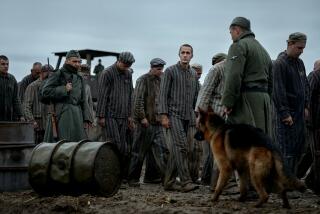All’s Well With ‘All Quiet’
The 1930 Oscar-winning epic “All Quiet on the Western Front” is considered one of the greatest antiwar films of all time, but that doesn’t mean it’s been treated like a masterpiece.
Over the past six decades, the World War I drama, based on Erich Maria Remarque’s bestseller, has been sliced and diced beyond recognition. Important scenes were axed both here and abroad due to censorship, politics, time constraints and film exhibitors’ whims. Music had been added to scenes that quite literally were supposed to be all quiet. The film became a faded, decimated shadow of its former self.
The Library of Congress’ Motion Picture Division spent more than three years restoring “All Quiet” to its original glory. The print also returns three minutes of footage that hasn’t been seen in decades.
American Movie Classics will show the restored version Friday as part of the cable network’s sixth annual Film Preservation Festival. This year, the three-day fund-raiser spotlights war films, documentaries and newsreels. Proceeds go to the Film Foundation, which distributes the monies to six film archives.
In fact, “All Quiet” was partially financed by AMC’s film preservation fund-raising efforts. David Sehring, AMC’s senior vice president of acquisitions and programming, began talks with the Library of Congress about “All Quiet” five years ago.
“This was one of the projects they saw as a perfect example of what film preservation and restoration is,” Sehring says. “Over the years, the film lost its original vision--the director’s vision.”
Masterfully directed by Lewis Milestone, “All Quiet on the Western Front” follows the harrowing adventures of Paul Baumer (Lew Ayres), a young German who begins World War I with his six friends as a patriotic, enthusiastic soldier. As he witnesses the horrors of war and watches his friends die in the trenches, Paul is transformed into a world-weary cynic.
Despite some stiff acting, “All Quiet,” which won Oscars for best film and director, still packs a wallop. The film, which was written by Maxwell Anderson, Del Andrews, George Abbott and an uncredited Milestone, also stars Louis Wolheim, Slim Summervile and Ben Alexander.
According to the Library of Congress’ David Parker, creative director of the restoration, Universal began chopping up the film as soon as 1933.
“They used the picture at Universal the same way most old pictures are used,” he says. “The first thing you want to do is reissue it. But you would have to have a picture on with it because it’s only half as good as a new picture. So they would cut it down to 1 1/2 hours from 2 1/2 hours, so it would fit into a double bill with the ‘King of Jazz.’ The exhibitors said nothing of importance will be left out.”
The film was reissued again in 1939, this time as an anti-Hitler film. “They put in all of this narration about Nazis,” Parker says. During the Korean War, two different companies re-released the film, each at a different length.
“When I saw it when I was in graduate school, I saw the speedy version,” he says. “They added horrible corny music at the end, which is suppose to be in dead silence.”
Parker believes there were at least 17 versions floating around Europe. “It was a sound version without dialogue, with music and effects and you cut in the title of your choice and the language of your choice. It might have been cut differently in every country.”
In France, for example, exhibitors excised a memorable scene in which Paul was trapped overnight in a foxhole with a dying French soldier. Still, Parker says, Universal has “worked very hard to get more and more complete versions out. They have a laser edition of the British version, but it has some damage and deterioration.”
With so many versions of the film in existence, the task of putting “All Quiet” back to its original form was made significantly easier by Universal. Not only did it help finance the restoration, the studio had preserved in its vaults a master positive print of the film. “They didn’t touch it for all of these years,” Parker says. “We found out what it was.”
Though Universal kept meticulous records, Parker says, it had misread them. A notation was discovered in the records that explained it was a master positive. “It turned out to be a pristine copy. That’s why it looks so good.”
One of the restored sequences that hadn’t been seen in decades features a crude version of the Last Supper in which the soldiers pass blood-soaked bread and a bottle of Cognac among themselves.
In most versions, the scene ends before the communal meal. “It stopped there because they were saving time, but that wasn’t what Milestone wanted. This makes it last a little longer, you have this obscene Last Supper, this perversion of Christian symbolism.”
The soundtrack has also been restored to Milestone’s original vision--deliberate silences intermingled with distorted sounds of weaponry and gun shots. Just as with the film, though, Parker had to honor Milestone’s original intentions.
“It isn’t like we don’t want [the sound] to be good, but we don’t want it to sound like it was recorded yesterday,” Parker says. “It was supposed to be of this period. I think there is only one place in the picture that we know where the sound is problematic--in reel 10. There is a problem with the sound being faintly recorded.”
Parker says the restoration has made the film more accessible to contemporary audiences.
“You don’t get the feeling it is distant,” Parker says. “It seems to be more immediate. . . . I think people will be pleased. It has a much better impact.”
*
“All Quiet on the Western Front” can be seen Friday at 9:45 a.m. and 6:30 and 10 p.m. on AMC.
More to Read
Only good movies
Get the Indie Focus newsletter, Mark Olsen's weekly guide to the world of cinema.
You may occasionally receive promotional content from the Los Angeles Times.











